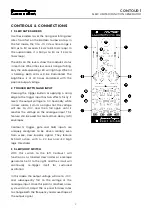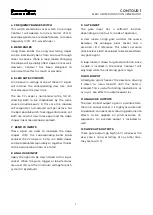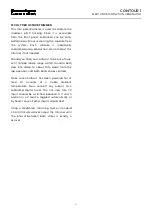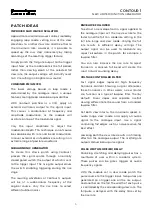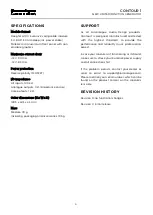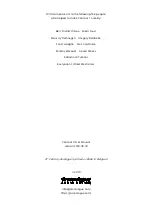
CONTOUR 1
SLEW LIMITER/FUNCTION GENERATOR
5
PATCH IDEAS
IMPROVED SAW WAVE OSCILLATOR
Approximate saw/ramp waves can be created by
engaging loop mode, setting one of the slew
directions to a rather slow rate and the other to
the maximum rate. However, it is possible to
speed up the saw ‘step’ immensely by taking
advantage of the resetting trigger feature.
Simply patch the fall gate output to the trigger
input. Now, as the module enters the fall period,
rather than slewing down at the selected fall
slew rate, the output voltage will instantly reset
to 0 V, resulting in a brighter saw sound.
COMBINED FM/AM VCO
The lower voltage bound in loop mode is
determined by the analogue input, a unique
feature creating deep modulation possibilities.
With Contour 1 patched as a VCO, apply an
external oscillator’s output to the signal input.
This causes a combination of frequency and
amplitude modulation, as the module will
oscillate ‘on top of’ the modulator signal.
Vary the input amplitude to adjust the
modulation depth. This technique can of course
be combined with rate and bend modulation,
manual, external or via feedback, resulting in an
extreme range of possible waveforms.
SUBHARMONIC GENERATOR
To create this classic patch using Contour 1,
process the signal source through a normally
closed gated switch, the output of which is sent
to the trigger input. The rise gate output drives
the switch, disabling triggering during the rise
stage.
The resulting waveforms at Contour 1’s outputs
will be at a subharmonic frequency of the
original source. Vary the rise time to select
different subharmonics.
ENVELOPE FOLLOWER
To extract an envelope from a signal applied to
the analogue input, set the rise slew rate to the
fastest and the fall to a moderate setting, in the
full rate range and slew mode. Varying the fall
rate results in different decay settings. The
output signal can be used to modulate any
aspect elsewhere in the patch, for example a
lowpass filter.
You can also increase the rise rate to reject
transients. A concave fall bend will create the
most ‘natural’ sounding decay.
VOLTAGE CONTROLLED FILTER
Fast signal edges represent high frequency
harmonic content. Slewing a signal attenuates
these harmonics. In other words, a slew limiter
can function as a type of lowpass filter. The (by
default) linear slopes and separate rise/fall
slewing differentiate the sound from a standard
lowpass filter.
Set both slew rates to the maximum speed, in
audio range slew mode, and apply an audio
signal to the analogue input. Use a signal
containing fast edges, such as a square wave, for
best effect.
Lowering both the slew rates results in a filtering
effect on the analogue output. The rise/fall gate
outputs deliver bonus pulse signals.
PULSE WIDTH MODIFIER/ DELAY
Shrinking, stretching and delaying pulses has a
multitude of uses within a modular system.
These pulses can be gates, triggers or audio
frequency signals.
With the module set in slew mode, patch the
pulse source to the trigger input. Two pulses are
generated on a trigger: one on the rise output,
and another on the fall. The width of each pulse
is controlled by the corresponding slew rate. The
fall pulse is delayed, with the delay time set by
the rise rate.


